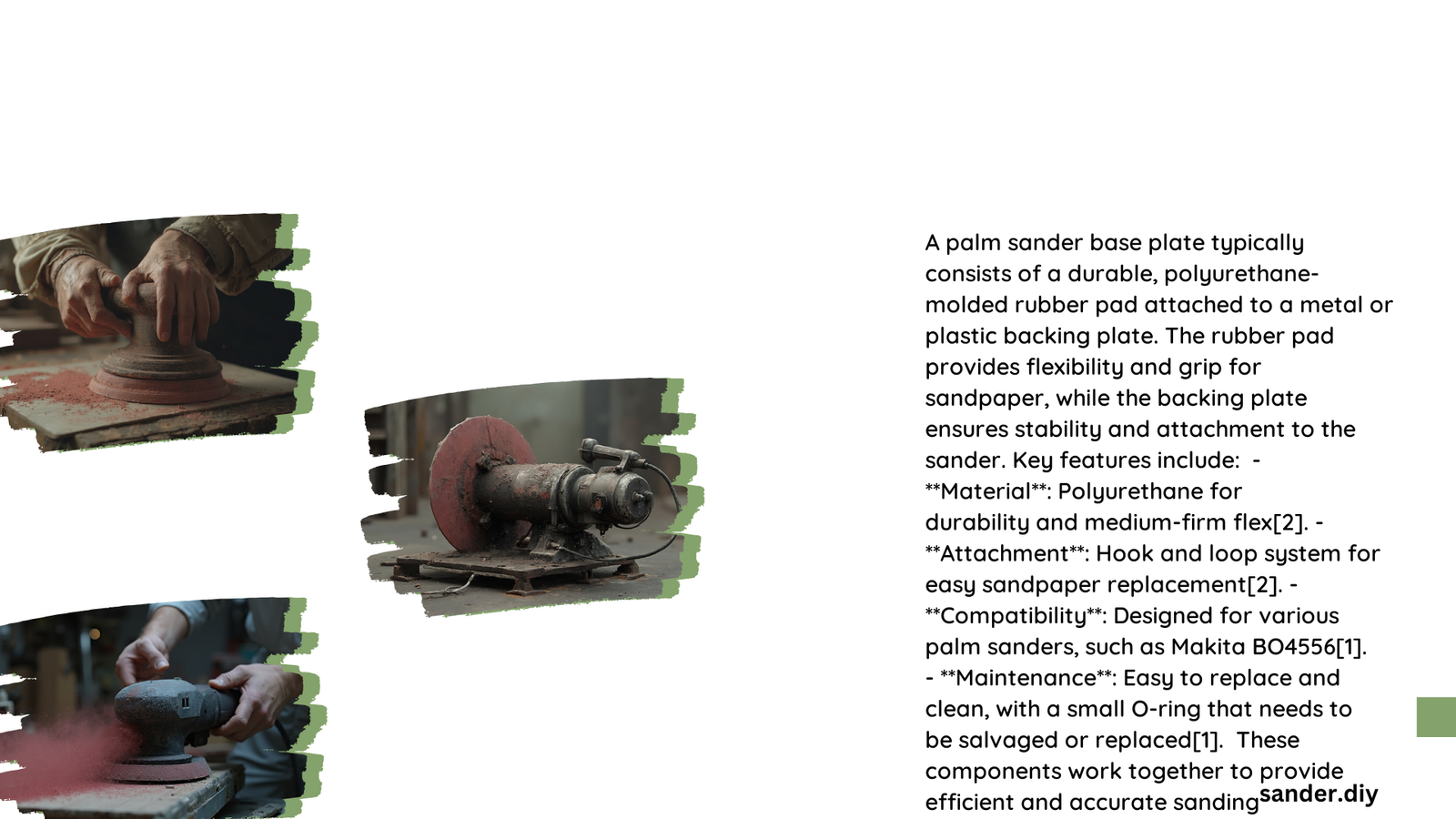Palm sander base plates are crucial components of palm sanders, providing a stable surface for attaching sandpaper and ensuring smooth, even sanding. These plates, typically made of rubber or a combination of materials, come in various sizes to fit different sander models. Understanding the specifications, materials, compatibility factors, and replacement process of palm sander base plates is essential for maintaining your sander’s performance and achieving optimal results in your DIY projects.
What Are the Key Specifications of Palm Sander Base Plates?
Palm sander base plates come in various sizes and shapes to fit different sander models. For example, the Makita BO4556 palm sander uses a base plate with the following specifications:
- Dimensions: 112mm x 102mm
- Material: Rubber backing
- Compatibility: Specifically designed for Makita BO4556 model
It’s crucial to note that base plate specifications can vary significantly between brands and models. Always check your sander’s manual or consult with the manufacturer to ensure you’re using the correct base plate for your specific tool.
What Materials Are Used in Palm Sander Base Plates?

Palm sander base plates are typically made from the following materials:
- Rubber
- Most common material
- Provides flexibility and grip
- Reduces vibration
- Enhances user comfort
-
Durable but may wear out over time
-
Metal components
- Used for attachment mechanisms
- Provides strength and durability
-
May be prone to corrosion if not maintained properly
-
Plastic components
- Sometimes used in combination with rubber and metal
- Lightweight and cost-effective
Each material has its advantages and disadvantages, contributing to the overall performance and longevity of the base plate.
How Do You Ensure Compatibility When Choosing a Palm Sander Base Plate?
Ensuring compatibility is crucial when selecting a palm sander base plate. Consider the following factors:
- Brand-specific requirements
- Many base plates are designed for specific brands and models
-
Using incompatible base plates can lead to poor performance or damage
-
Attachment mechanisms
- Different sanders may use various methods to secure the base plate
-
Common mechanisms include screws, clips, or adhesive backing
-
Size and shape
- Base plates must match the sander’s dimensions precisely
- Incorrect sizes can result in uneven sanding or damage to the tool
To avoid compatibility issues, always:
– Check your sander’s manual for recommended base plate specifications
– Consult with the manufacturer or a reputable dealer
– Verify the exact model number of your sander before purchasing a replacement base plate
What Is the Process for Replacing a Palm Sander Base Plate?
Replacing a palm sander base plate is generally a straightforward process. Here’s a step-by-step guide:
- Gather necessary tools
- Screwdriver (matching the screws on your sander)
- New base plate
-
Replacement screws (if not included with the new base plate)
-
Remove the old base plate
- Unscrew the fasteners holding the old base plate in place
-
Carefully detach the old plate from the sander
-
Clean the sander surface
- Remove any debris or adhesive residue
-
Ensure a clean surface for the new base plate
-
Attach the new base plate
- Align the new plate correctly
-
Secure it using the appropriate screws or attachment mechanism
-
Test the sander
- Turn on the sander to check for proper alignment and function
- Make adjustments if necessary
The entire process typically takes 5-15 minutes, depending on your experience and the specific sander model.
What Are the Costs Associated with Palm Sander Base Plate Replacement?
The costs of replacing a palm sander base plate can vary based on several factors:
- Brand and model
- OEM (Original Equipment Manufacturer) parts may be more expensive
-
Generic alternatives might be available at lower prices
-
Material quality
- Higher-quality materials often come with a higher price tag
-
Budget options may be less durable but more affordable
-
Retailer or supplier
- Prices can vary between different sellers
- Online marketplaces may offer competitive pricing
For example, the Makita 158324-9 base plate for the BO4556 model typically costs between £10-£20, depending on the retailer.
| Cost Factor | Price Range |
|---|---|
| OEM Parts | £15 – £30 |
| Generic | £5 – £15 |
| High-End | £25 – £50 |
It’s important to balance cost with quality to ensure you’re getting a durable and compatible base plate for your sander.
How Can You Extend the Life of Your Palm Sander Base Plate?
To maximize the lifespan of your palm sander base plate, consider these maintenance tips:
- Regular cleaning
- Remove dust and debris after each use
-
Use compressed air or a soft brush to clean hard-to-reach areas
-
Proper storage
- Store your sander in a dry, cool place
-
Avoid leaving the base plate in direct sunlight or extreme temperatures
-
Even pressure distribution
- Apply consistent, even pressure while sanding
-
Avoid tilting the sander, which can cause uneven wear on the base plate
-
Use appropriate sandpaper
- Ensure the sandpaper is properly sized and attached
-
Avoid using overly aggressive grits that could damage the base plate
-
Inspect regularly
- Check for signs of wear or damage before each use
- Replace the base plate at the first signs of significant wear
By following these tips, you can significantly extend the life of your palm sander base plate and maintain optimal sanding performance.
